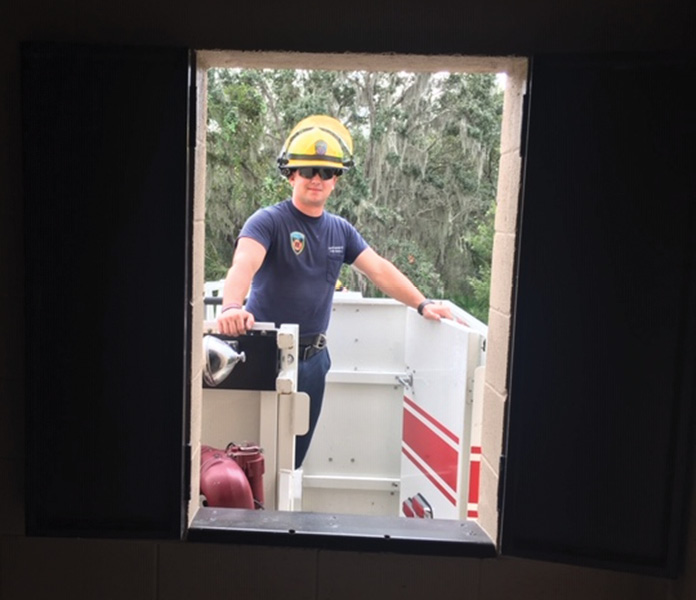
By Louis Sclafani
Whether on social media or around the kitchen table at the firehouse, you’re presented with a picture or video of someone else’s fire. A discussion ensues about strategy and tactics. Inevitably, one of the questions asked is, “Where would you position your apparatus?” And the debate begins. For this article, the only apparatus we will be considering is an aerial device, otherwise known as the truck.
No matter what type of fire, as you approach the scene you should note some common factors. Are you here for fire attack or victim rescue? What is the location of the fire? Is there a collapse potential? Do you have enough available space to set up? After that, it’s time to go to work. Listed are a number of do’s and don’ts that hold true for every truck at every incident in every department. Let’s look at some of them.
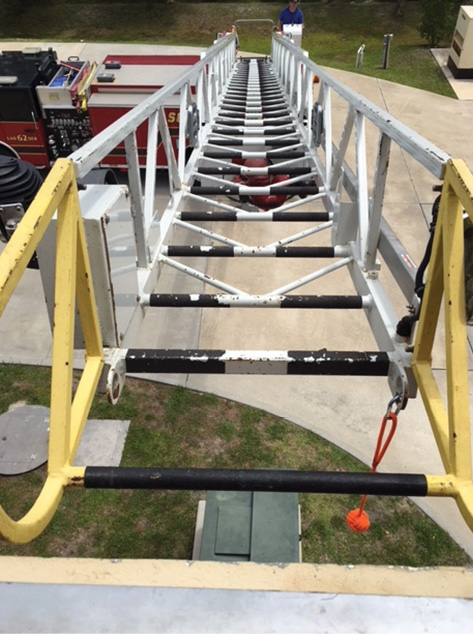
(1) Although the tips of the aerial ladder are square with the window, the bottom rail is even with the windowsill. From this position, it is more difficult to enter and exit a window. (Photos by author.)
Don’ts and Do’s
Don’t take a position before assignment. Do know what your job is before positioning. You want to be in the right spot the first time. You can’t stretch your aerial like you can more hose. Think, what is the best position I can be in for the task that has been assigned to me? Don’t just accept any space in the general area. I call it “positioning for objective.” Of course. you will have to work around other apparatus that may have arrived before you and other on-site obstructions, but you must put thought into placing yourself in the best position available for your objective.
Don’t position the driver’s seat to your objective. Do position the turntable to your objective. You have been given your assignment and are positioning accordingly. Whatever your objective—a window, the roof, or any opening—you want your aerial tip at that spot. That means you have to line up the other end of the aerial device, the turntable, with your objective. Don’t get in the habit of lining up your target with where you sit behind the steering wheel in the cab.
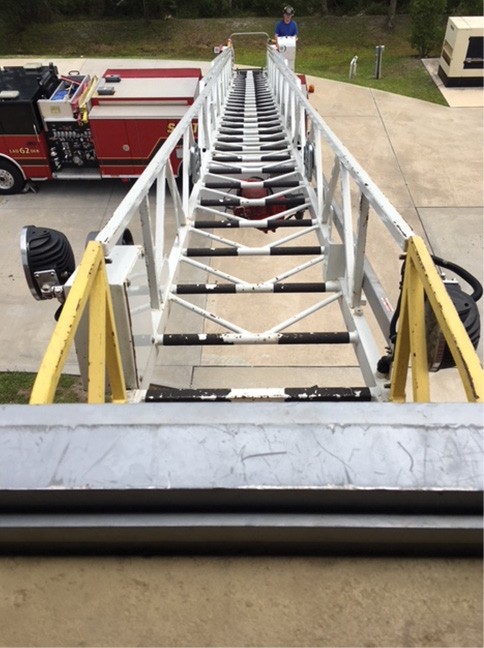
(2) The tips of the aerial ladder are square with the window and the top rail is just below the windowsill. This allows unobstructed entry and exit through the window onto the ladder.
From the cab of the truck, the operator is looking at the building, looking back at the turntable, lining everything up. It’s considerably easier to do this with a mid-mount aerial since the turntable is much closer to the driver than it would be with a rear mount. Regardless of which type you have, if you get out of the cab, stand at the turntable, and look up at your objective and see that you’re not in the best spot, take a few seconds to reposition. This is much better than setting up and being off line of your target.
Don’t make window rescues harder than they have to be. Do line up properly to get victims down safely and efficiently. Upper-floor window rescues are a high-risk, high-reward, low-frequency event. The truth is, even though we rightly consider rescue our highest priority on the fireground, we rarely rescue people from upper-floor windows. When it does happen, it’s that once-in-a-career call that will likely be talked about in your area for years to come.
If your truck is a “ladder,” I have found that the optimum position for a window rescue is to have the tips square with the windowsill. You can deploy your ladder off the rear, 900 off the side, or over the front for this position. If you put the top rail of the ladder just below the windowsill, there will be no obstructions when climbing out the window (photos 1 and 2). This is the easiest way to climb out of a window and onto the ladder. If you are unable to take this position, the next best position is having the truck next to and parallel to the building but short of the window if working over the front of the truck or beyond the window if working off the rear of the truck (photos 3 and 4). Once you extend the ladder to the window, again, keep the top rail of the ladder under the windowsill (photo 5). This allows firefighters and victims to straddle the windowsill and provides more balance as they climb in and out of the window (photo 6). It is preferable to have the tip several feet past the face of the window as well. This allows more room for a firefighter to stay at the tip and assist victims out of the window. If you can’t park your truck in either of the above positions, you can still come in at an angle, but it will be much more difficult for firefighters and Mrs. Smith to climb in and out.
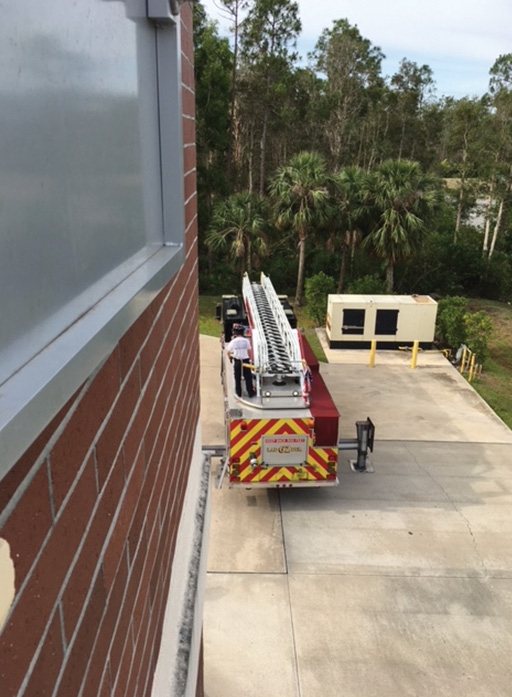
(3) The truck has pulled past the window and positioned close to and parallel with the building.

(4) Working off the rear of the truck, the ladder is rotated and extended to the window.
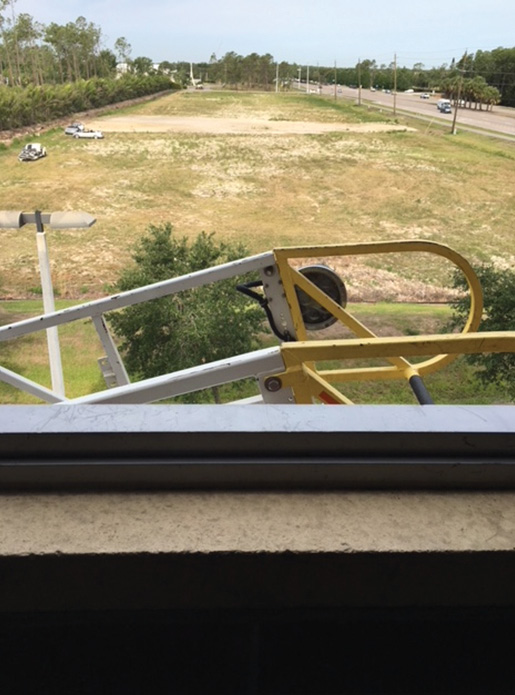
(5) Lower the top rail of the ladder until it is even with the windowsill. This position reduces obstructions and allows easier access into and out of the window.
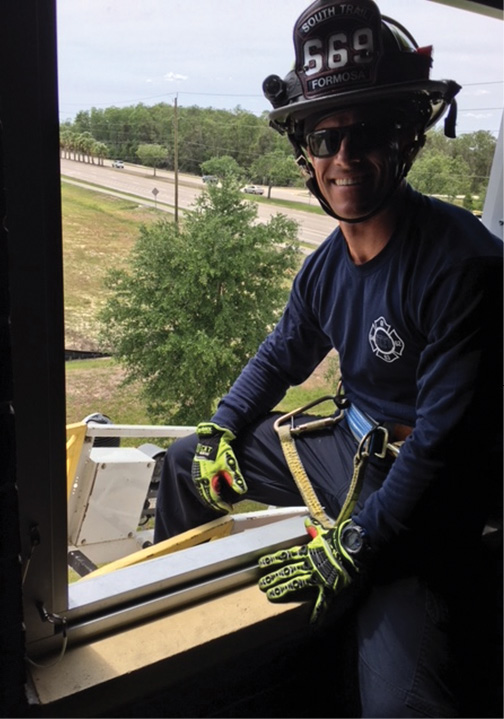
(6) Whether the ladder tips are square or parallel to the building, lower them so rescuers and victims can straddle the windowsill, allowing the easiest access in and out.
If you are making a rescue with a platform, the same positioning advice applies but with modifications. If your platform has a door in the center of the bucket, try to line the door up square just like a ladder tip (photo 7). If your platform has doors off center or on the corners, try to line up one of the doors with the window. Since most platforms have a step on the outside, you have some tolerance on lining up. It’s fairly easy to climb out onto a step and into the platform, especially if the platform is square with the window. Once near the window, lower the platform so the windowsill is about halfway down the platform (photo 8). This way, a victim or firefighter can straddle the windowsill while climbing into or out of the platform (photo 9).
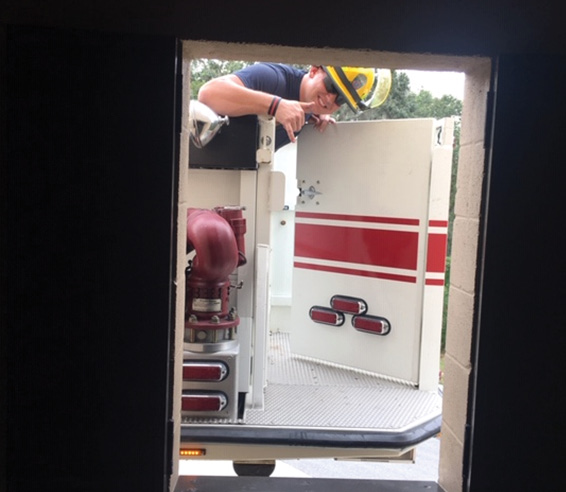
(7) If entering or exiting onto a platform from a window, it is best to square up your door with the window. Although some may suggest keeping the floor of the platform even with the windowsill, this position makes it hard to climb in and out.

(8) The better position for a platform when you enter it or exit from it is to lower it about halfway. This allows easier entry and exit.
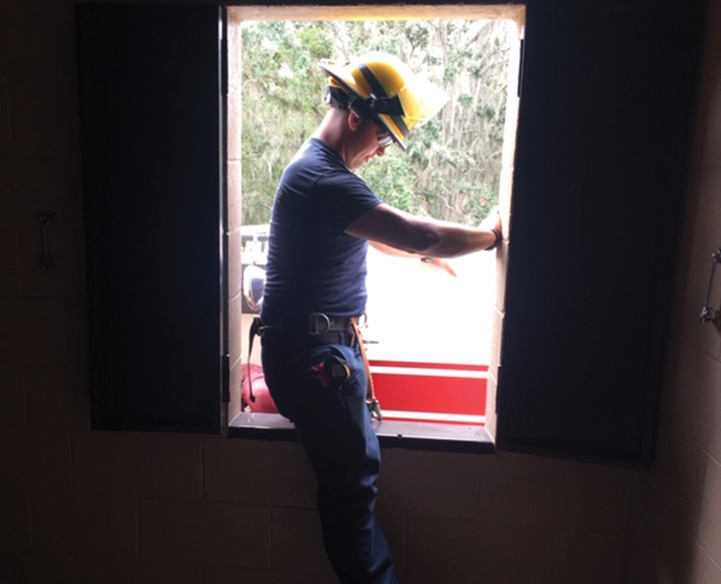
(9) With the platform in the proper position, it is easier to enter and exit a window.
If you can’t get your platform square with the window, try taking the next best position, which is positioning the truck parallel to the building. From this spot, there are a few options for positioning the platform for entering and exiting a window.
This option works best if your platform has a corner door. Extend your platform to the window and lower it so the bottom half of the platform is below the windowsill. Don’t extend more than about one-quarter of the way across the face of the window. You need room to climb in and out. From here, you should be able to more easily climb into and out of the window (photos 10 and 11).

(10) If using a platform and you are unable to square up with the window, coming in parallel is a good option.
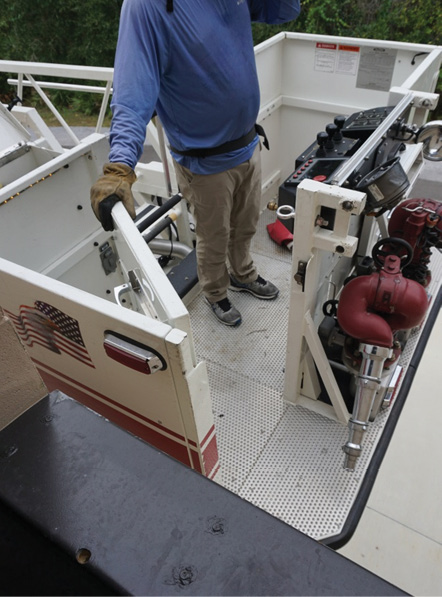
(11) This platform has a door on the corner and a step on the outside of the door, making it easy to get in and out of the window and onto the platform.
The next option would be best if you needed to drag an unconscious victim into your platform and you couldn’t do it through a door. From the position mentioned above, it would not be difficult to drop a victim while being transitioned from the window to the platform. To help prevent this, extend the entire platform across the face of the window and treat the top rail of the platform as you would the top rail of the ladder by lining it up with the windowsill. You will have to climb over the top of the side of the platform to get in and out. It is not easy, but it’s better than dropping your victim (photo 12).

(12) If you must remove an unconscious victim and are unable to drag the person through a platform door, you must bring the victim over the top rail. This necessitates that you lower the platform at least to windowsill level.
I know of at least one model of truck that has one door on the side of the platform. If this is the case, instead of going over the top rail, line up the side door with the window and drag in the victim. Be sure to position so that the side of the platform with the door is lined up with the window and not the other side. It would be pretty embarrassing—not to mention more difficult—to have the side door on the wrong side of the platform when making a rescue. If your platform has master streams mounted on the side, that will make entry and exit over the top rail more difficult. Almost any other position would be better. So, given the space, don’t make window rescues harder than they have to be. Position so you can more easily climb in and out of a window. Mrs. Smith will thank you.
Don’t become a 60,000-pound hose clamp. Do check your tires and stabilizers to make sure you’re not on anyone’s hose. If you run over charged supply hose, you will likely know it from the bump. But running over uncharged hose or small-diameter hose can easily be missed. Running over hose is bad. Stopping on the hose is worse. Luckily, you have positioned your truck and missed all the hose. You exit the cab and deploy your stabilizers. Take that last look on the opposite side to confirm there is no hose under the stabilizer pad. There may not have been any there when you parked, but it’s possible that hose has been deployed since then. Don’t cut off the water supply, making the situation worse.
Don’t position in front of a building with a big parapet if you are going to the roof. Do go to the side or rear of a building if you encounter big parapets. You have been dispatched to a fire call at the local big box store. Your department standard has the truck positioning in front of the building. The incident commander (IC) orders you to the roof. You raise your device and look over the parapet. Usually, you can use your roof ladder or some other portable ladder attached to your device to get over the parapet. But not this time. The parapet on the front of many big box and grocery stores is too high. Add “parapet height” to the list of things you look for when preplanning. Normally, on those same buildings, you will find the side and rear of the buildings have short parapets or no parapets at all. So, once given an assignment and you “position for objective,” you may have to leave the front of the building as called for in your standard operating procedures (SOPs) and position at a more realistic spot.
Don’t position too close to the building for low window access or a low level fire attack. Do know the horizontal reach of your device when fully retracted and stay at least that far back. When we talk about setting up and being able to reach a building with our aerial, the more common concern of operators is being too far away and coming up short of their objective, a very valid concern. On occasion, however, we need access to a window on a lower level or perhaps the IC has called for a defensive operation and wants to use your master stream at low or ground level. What a great way to quickly and easily apply large volumes of water! Because of the narrow width of some streets, a potential negative issue arises if you are too close to the building when you raise and rotate your device. If you are not back far enough, you will not be able to rotate your device to meet your target. The building will be in the way. Again, if you “position for objective” and you know the fully retracted horizontal reach of your device, you can park at least that far away and still fully rotate at a low angle for fire attack or window access.
Don’t allow your aerial to become an exposure. Do position far enough away that radiant heat and convected heat don’t negatively affect your truck. The reality is that most of us see fire only occasionally. Let’s call this a testament to our building codes, fire inspections, protection systems, and public education. As a result, our experience level is not what it used to be. When we do see fire, it’s more typically room-and-contents and a handline-or-two type of fire. When we get the “big one,” we shouldn’t position in the same spot as we would for the smaller fire. Think “big fire” with lots of radiant heat. Think collapse potential with a sudden and violent release of convected heat. When I see photos of crews with handlines turned toward their vehicles, covering it as an exposure, I think, “Oops, I bet that wasn’t the initial plan.” Expect the unexpected. It may get worse before it gets better. Position far enough away so that you don’t cook your truck.
Don’t let signs, awnings, or structural building components fall onto your aerial. Do stay far enough away so that falling debris misses your aerial. It’s a big defensive firefight. The IC has ordered you to raise your device and flow your master stream. Although exciting, as mentioned above, this type of fire is not as common as the room-and-contents fire. You raise your device and place it mere feet from the opening of a window. You begin to flow thousands of gallons of water a minute. If you are defensive, why do you need to place the nozzle so close to the building? Our streams can travel pretty far. On these big, defensive fires, building or component failure is not only possible but probable. Yet, knowing this, there have been reports of items falling on and damaging aerials during a defensive firefight. You can place your tip 20 feet or more from a building and still effectively apply water with your master stream. Positioning your truck out of the fall/collapse zone will help prevent your device from being struck by falling debris.
If we understand that all of our communities, structures, vehicles, and situations are different, we have to realize that there really are no SOPs on fireground positioning that work for all of us all of the time. However, if you follow these do’s and don’ts, you should have a safer and more efficient truck crew on the fireground, especially if you “position for objective.”
Louis Sclafani is a retired district chief from Pinellas Park, Florida. He is the lead aerial instructor at St. Petersburg College Fire Training Center and will teach on aerials at FDIC International 2019.

